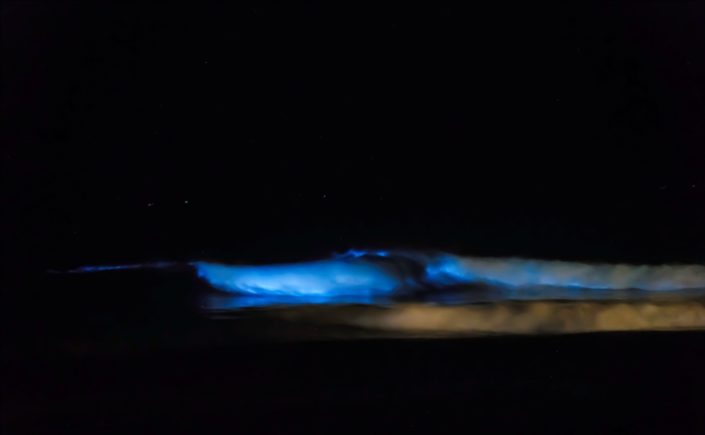Bioluminescence is simply the emission of light from a living organism that functions for its own survival or propagation. The process of light emission from an organism should be differentiated from other forms of luminescence.
Bioluminescent organisms are seen throughout the biosphere but generally at the levels below mammals and plants. The reaction has been demonstrated in cephalopods, copepods, ostracods, amphipods, fishes, annelids, and jellies. Many of these organisms are found on the land, for example, insects like fireflies, glow-worms, and beetles.
There are also some luminescent fungi accountable for the glow seen on the tree barks during the night. The bioluminescent bacteria are found both terrestrially and in the marine environment. Other most luminous organisms in the deep sea are yet to be investigated.
Aristotle was one of the first researchers to make observations of luminescent species. Then later, there were many detailed and wide-ranging accounts of luminous organisms got recorded. The discovery of these bioluminescent organisms had been the aim of many marine researchers. Luminous organisms found at coastal areas are more accessible and can be collected by methods that are not really expensive.
Anatomic position of bioluminescence gives hints as to the source of component synthesis, storage, transport, and the functional role of the luminescence. One essential organ is “photophore” or the light producing organ, which is manifestly seen in many luminous fishes and intensely in cephalopods.
Photophores are usually made up of complex photogenic cells i.e., light emission cells. These components have also been spotted in the stomach, secretory organs and liver of some organisms. They are generally present as a result of synthesis or storage functions.
Bioluminescence has a significant role in the ecology of the oceans
The function is more clearly understood in the framework of the essentially dark environment usually below 200 m in the ocean. Purpose of bioluminescence is defence, lure, feeding, communication, mating, and camouflage.
It can help an organism to find food in the dark, working as a flashlight. The flashlight fish is one good example of it. Bioluminescence can also act as a lure to attract prey. The viperfish has a luminescent lure on the edge of an altered fin ray which it can march forward at the front of its mouth. In the all dim depth, prey sees a glowing morsel and can hit quickly by the enormous fangs. These fangs are so long that viperfish would impale its own brains if they were inside its mouth. Bioluminescence can also attract a mate. They function in mate selection since the light organs of males are comparatively larger than those of females.
Bioluminescence can also serve a protecting function to an organism from predators. Deep-sea shrimp use it to sidetrack or blind a predator. Shrimp throws light on the face of the attacker and then backflips into the dark deep ocean. Other organisms use this interesting tool to cry for help. Once an organism is trapped; its only escape is to attract the attention of something superior, which may attack and eat its attacker.

Bioluminescence also serves as camouflage
In the dim depths, the shape of an animal can be seen against the dim blue light coming down; it works as an easy target for an attacker. Hatchet fish have upturned eyes and an upturned mouth, and this makes it easy prey to bigger fish swimming below it. Hatchet has a narrow shape and silversides.
It emits bioluminescence from the belly, which is a perfect match in colour and intensity to the sunlight coming down from the surface. If it is cloudy, the fish dims the bioluminescence to continue to blend into the background. This trick is called counterillumination. This saves the fish from the bigger fishes.
The Principle
There are five distinct luciferins accountable for the bioluminescence reaction in most of the known organisms. They are bacterial luciferin which is basically derivative of riboflavin, dinoflagellate luciferin (related to the chlorophyll structure), firefly luciferin (requires ATP for reaction), coelenterazine, and vargulin (found in Ostracods). Phosphoreum is known to be involved in the emission of intense luminescence.
The reaction of bioluminescence involves a light-emitting pigment called luciferin, and a luciferase, which is the enzyme component. From recent studies, the amalgamating mechanism is the role of molecular oxygen, although various examples show the concomitant release of carbon dioxide.
The firefly shows luciferin/luciferase reaction, which requires magnesium and ATP leading reproduction of carbon dioxide (CO2), adenosine monophosphate (AMP) and pyrophosphate (PP) as surplus products. Generally needed cofactors are calcium (Ca2+) which is required for the photoprotein aequorin, or magnesium (Mg2+) ions and ATP that are required for luciferase. Coelenterazine type of luciferin found in various distinct marine phyla from comb jellies to vertebrates.
Like all the other luciferins, it is oxidised leading to the production of light. The jellyfish Aequoreavictoriause protein called as the photoprotein, here specifically called as aequorin. When calcium ions are added further as cofactors, the fast catalytic reaction generates a momentary flash which is quite unlike the prolonged glow generated by luciferase.
In a second dawdling step, luciferin is redeveloped from the oxidised form called as oxyluciferin, permitting it to recombine with aequorin, for a further flash. Photoproteins are with unusual reaction kinetics. Further, some blue light emitted by aequorin in interaction with calcium ions gets absorbed by a green fluorescent protein, which releases green light in a process. It is called resonant energy transfer.
Bioluminescence has ascended over around forty times in history. In the whole evolutionary phase, luciferins tend to vary a bit; coelenterazine is the light emitting pigment for around nine phyla, including polycystine, protozoa, comb jellies, cnidaria including jellyfish and corals, molluscs, and vertebrates (ray-finned fish). Not all of these make coelenterazine: some obtain it via their diet. Contrariwise, luciferase enzymes tend to be different in each species varying widely.
By- Sciencemonk.com










